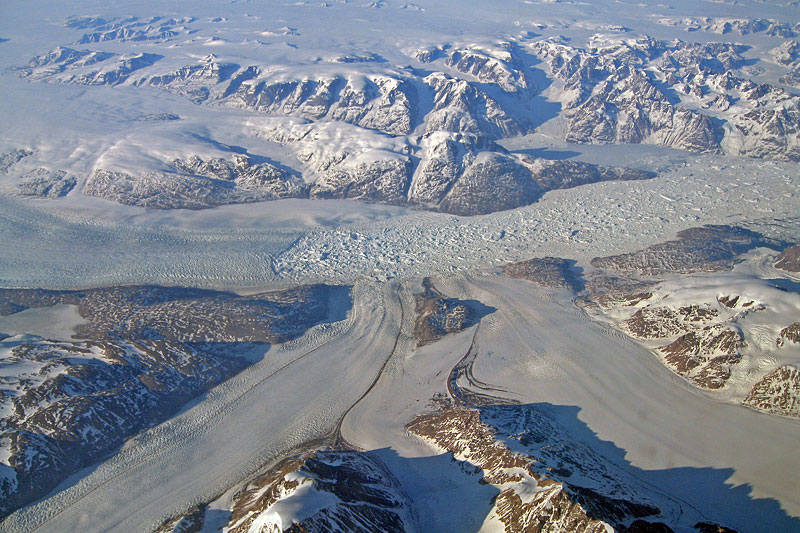Featured Stories, MIT, MIT Oceanography, WHOI | March 24, 2013
More to Melting Glaciers than Meets the Eye
By Genevieve Wanucha

From afar, glaciers and ice sheets appear to be solid blocks of ice, but inside they actually contain a complex system of crevasses, cracks and conduits. When a glacier melts, the runoff travels to the bedrock and sediment below through large tunnels and drains into the ocean via rivers. Conventional wisdom once held that glacial meltwater was simply a source of biogeochemically dilute freshwater to the ocean.
In the 1990s, a team of Canadian researchers discovered bacteria thriving on the wet undersides of Swiss and Arctic glaciers. Back in the lab, they noted that some of the bacteria produced their energy by oxidizing sulfide, a process that yields iron as a byproduct. “It’s fair to say we didn’t pay a lot of attention to that at the time,” says Martin Sharp, Professor and Chair of Earth and Atmospheric Sciences at the University of Alberta. But it wasn’t long before others connected the dots; glacial meltwater could be picking up iron from the subglacial ecosystem and transporting it into the ocean. Since then, a still growing line of inquiry has opened into whether glacial iron can significantly impact marine systems.
Phytoplankton require iron to survive and thus to produce half the oxygen in the atmosphere, form the base of the food web, and suck up carbon dioxide gas. The amount of bioavailable iron limits how much they can do so. In the Southern Ocean, biochemist Rob Raiswell has shown that the dirty bottoms of icebergs transport floating oases of iron far offshore to stimulate phytoplankton productivity in the close vicinities. The North Atlantic is thought to receive most of its iron from airborne dust. Not so fast. Glacial meltwater may be adding just as much, according to a Greenland-traversing team of Woods Hole Oceanographic Institution researchers who published in March’s advance online edition of Nature Geoscience.

During the course of two expeditions to the Greenland ice sheet in May and July 2008, WHOI glaciologists and biochemists collected meltwater samples from sites at three land-terminating glaciers. The team ultimately calculated that the Greenland ice sheet runoff contained iron at micromolar concentrations–several orders of magnitude higher than the nanomolar amount recorded in the one existing prior study.
“Most people think melting glaciers and ice sheets are important in terms of predicting sea level rise,” said the study’s lead author, Maya Bhatia, then an MIT/WHOI Joint Program graduate student and now a post-doc at the University of British Columbia. “But it’s interesting to think there could be other ramifications from the chemical input coming from these runoff rivers that have a very different chemical characteristic from regular rivers.”
Plausibly, glacial meltwater could add enough iron to intensify phytoplankton blooms and boost their atmospheric carbon dioxide uptake, especially considering that the Greenland ice sheet’s freshwater flux to the ocean spiked 38% from 1992 to 2010. There’s reason for this hypothesis. Previous research shows that airborne dust doesn’t contribute sufficient iron to support maximum primary productivity in the North Atlantic in spring and summer. Moreover, oceanographers recently documented a strong correlation between the intensity of the spring plankton blooms in the North Atlantic Ocean and the amount of water draining off the Greenland ice sheet. Could iron in glacial meltwater be the missing link?

While it’s certain that iron is coming from under the glaciers, no one has confirmed that the nutrient is reaching iron-limited ocean regions or if it’s even bioavailable to organisms. “We don’t really know if the iron will spur additional algal blooms that will take in more atmospheric carbon dioxide. That’s the first step, and until we know that, we won’t know the ultimate effect,” says Bhatia, who also notes that the better-studied glacial contribution of dissolved organic carbon provides additional feedback loops to consider.
Martin Sharp, whose 1999 study spearheaded this biogeochemical line of glacier work, underscores that this research is still stuck at square one. He notes that the WHOI group’s measurements might be biased on the high side, as they were taken at the beginning and near the end of the melt season, a time when glacial runoff contains relatively high concentrations of solute, and then extrapolated to the whole ice sheet. “We need to get a firmer number for the total flux from the whole ice sheet,” he says. “Nonetheless, on the basis of the data available, the message is still clear it could be significant and it’s worth looking at further, for sure.”
The emerging view of glacier and iceberg ecosystems as significant sources of iron could lead to major revisions in paleoclimatology. The Earth has gone through times when half its surface was covered in ice. What was the effect of the subglacial iron cycled by ice-dwelling microbes when all that ice melted into the ocean? And how much did changing patterns of release and storage shape the Earth’s atmosphere into what it is today? It’s up to climate scientists to complete that puzzle, but not before a mix of biogeochemists, oceanographers, and microbiologists begin to understand that which flows from microbes beneath glaciers into microbes under the sea.






